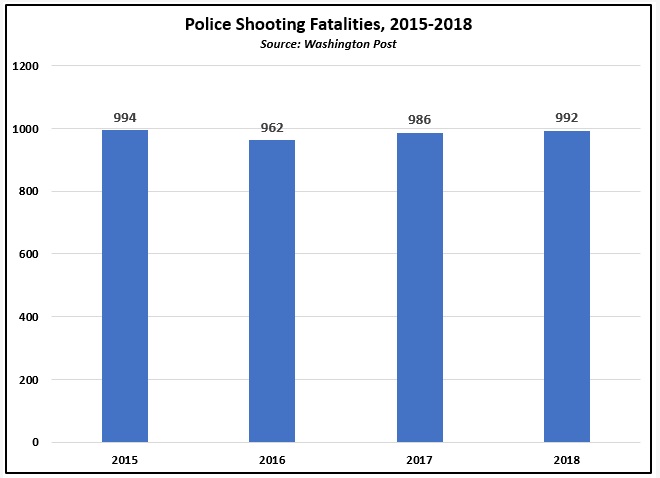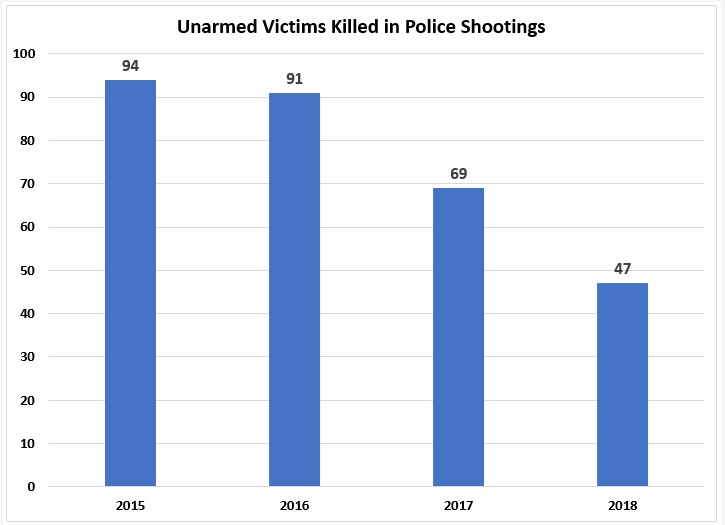According to data gathered and published by the Washington Post, the number of people killed in police related shootings has varied little from year to year during the period of 2015 to 2018.
However, the number of police related shootings involving unarmed victims has fallen dramatically during the same period.
In this report the word victim is defined as a person killed as a result of a crime, accident, or other event or action.
The Data
The Washington Post began gathering data on police shootings in 2015. The data does not address deaths by other means and does not track the outcome of investigations of the incidents. The research project began after the death of Michael Brown in Ferguson, Missouri in 2014.
The Post won a Pulitzer prize for the research in 2016. See details at end of report. Read more details about the project at end of report.
Support Local Journalism with a $50 Annual
Tallahassee Reports Subscription
_______________
Police Related Shootings
From 2015 to 2018, the total number of police shooting fatalities ranged from a low of 962 in 2015 to a high of 994 in 2016. See chart below.

The frequency of police related shootings in 2018 based on total arrests and violent arrests are shown below.
- Nationwide, law enforcement made an estimated 10.3 million arrests in 2018. The means that in 2018 there was one police related shooting death for every 10,383 arrests.
- In 2018 there 521,103 arrests for violent crimes. Based on arrests related to violent crimes, there was one police related shooting death for every 525 arrests.
Unarmed Victims
The Washington Post database data includes information that indicates if the shooting victims were armed are unarmed. The chart shows that the number of police related shootings of unarmed victims for each year from 2015-2018.
The data shows that nationwide the number of unarmed victims of police related shootings have fallen during each year from 2015 to 2018. In 2015 there 94 such shootings. The number fell by 50% to 47 in 2018.
Data for 2019, which can still change based on more information, show 41 unarmed shooting deaths.

The frequency of police related shootings of unarmed victims in 2018 based on total arrests and violent arrests are shown below.
- Nationwide, law enforcement made an estimated 10.3 million arrests in 2018. The means that in 2018 there was one police related shooting death of an unarmed victim for every 219,148 arrests.
- In 2018 there 521,103 arrests for violent crimes. Based on arrests related to violent crimes, there was one police related shooting death death of an unarmed victim for every 11,087 arrests.
About the Washington Post Police Shooting Database
The Post won a Pulitzer prize for the research in 2016. From the Post:
“The Post soon marshaled an extraordinary team of reporters, editors, researchers, photographers and graphic artists to do just that. The result was a database containing the details of 990 fatal police shootings across the nation in 2015 and a series of articles describing trends in the data.”
“The Post’s series was awarded the Pulitzer Prize in the national reporting category. The prizes, in their 100th year, are newspaper journalism’s highest honor.”

Can you also do charts on Tazzers? I know people have died from being Tazzed and the Elected Officials like to twist things for their agenda, one day they ARE a Deadly Weapon and the Next, they are NOT a deadly Weapon.
Pulitzer Prizes are tarnished.
One was awarded to the St. Louis paper for the Ferguson riots, as they perpetuated the false claim of “Hands Up, Don’t Shoot.”
Another went to the NYT/Wash. Post for “Russia, Russia, Russia” – Fake News!
If you look at their board members’ credentials, it is clearly run by illiberal AOC-like activists in Columbia, NY posing as journalists.
The use of the term “victim” is misleading in the Post’s article and by Tallahassee Reports.
The Bureau of Justice Statistics defines a “victim” as “The recipient of a criminal act, usually used in relation to personal crimes, but also applicable to households.”
I strongly believe a huge percentage of unarmed people shot by law enforcement are not “the recipient of a criminal act” and would rather fall under the Bureau of Justice Statistics definition of “Offender” which reads, “The perpetrator of a crime. This term usually applies to crimes involving contact between the victim and the offender.”
Source: https://www.bjs.gov/index.cfm?ty=tdtp&tid=9
Excellent post… well done.
The trouble is, we just don’t know. And the terminology (e.g. “police related”) seems intentionally ambiguous. For that matter, police reports don’t start at the beginning, but in the middle or even near the end. What was the chain of actions leading up to an event? Even during trial (for the small number of cases that reach trial) there’s an odd dance that impedes disclosure of important information.
As you say, who, exactly, if anyone, initiated the force or fraud in each case?
Jurors should be able to have a neutral officer of the court (neither prosecutor, nor defense lawyer, nor judge) ask witnesses questions on their behalf & without interference of those others.